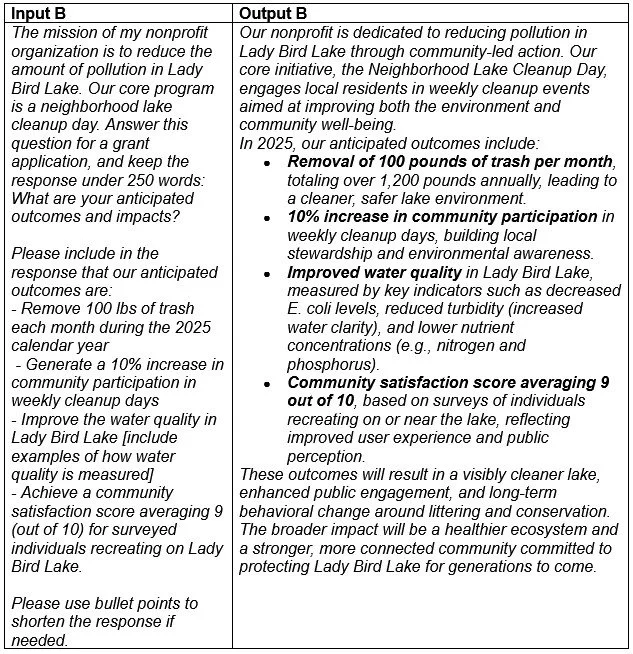Using AI to Write Grant Applications
Best Practices from Professional Grant Writers
I was a ChatGPT hater not long ago, sitting on my metaphorical front porch and wagging my finger to get yourself and your ChatGPT off my lawn. I’m a former English teacher, recovering academic, and current nonprofit consultant, so it would be fair to say I fit the profile.
While I still have my qualms about AI (namely, the environmental impacts produced by a single search query on ChatGPT), I’m beginning to agree with those who see generative AI as another tool that will become part of our everyday lives. Just as calculators improved our collective ability to do math more quickly, accurately, and complexly, AI has the capacity to help us become better writers, understand our own voice, and get our points across in a meaningful way.
AI can absolutely help grant writers and nonprofit professionals write faster. But it will do so at the expense of quality—unless we learn it as a tool.
So, in the spirit of learning a new gosh darn technology, here are my top takeaways about using AI to write your next grant application.
Tip #1: Make Your Input as Clear as Possible
When I was learning to use a graphing calculator in middle school, misplacing a single parentheses would throw off the entire output. I think of AI in much the same way: If you want a clear response, you need to feed the computer clear instructions. Here’s an example:
Feeding the computer vague information yields vague results, as we can see above. The AI-generated response is decent: It responds to the prompt with two examples of outcomes and a concluding paragraph about the broader impacts of the work. However, it’s missing the specificity that a prospective funder will be looking for.
Below, I’ve sharpened the input by feeding the computer more details about what I need and adding some notes around formatting.
With a clearer input, the results are much more aligned with what a funder will expect when reading your grant proposal. It includes several examples of outputs, all of which are distinctly measurable—and that’s the real key. Rather than asking the AI to think for us, we’re training it to think with us, and the result is much stronger for it. Your AI isn’t thinking like a fundraiser, so you, dear grant writer, need to ensure you feed it those gold nuggets of expertise.
Tip #2: Edit Your Robot Writing
When I do use AI to help with my work, I consider its output a starting point. This is best practice for anyone leveraging ChatGPT and other AI. Skipping the editing process is a missed opportunity for refining your sentences, ensuring you’re answering all parts of the prompt, and maximizing what you can accomplish in the word limit.
These are some of my go-to tips for editing your ChatGPT results:
Get rid of the bold phrases. This type of formatting often won’t stay when you copy and paste your responses into the funder’s grant portal. It can also be visually distracting; emphasizing too many things is as good as emphasizing nothing.
Eliminate extraneous words/phrases. We’re aiming for clear and concise responses, and your AI tends to spit out a lot of what your high school English teacher called “fluff.” My go-to spots for identifying the “fluff” are the beginning and the end of a response, where it’s especially likely to show up.
Alternate between using pronouns (e.g., “we,” “our”) and using your organization’s name. Grant reviewers often read handfuls of applications at a time, and it never hurts to make sure they know your organization’s name.
Beware the em dash. ChatGPT LOVES these little punctuation marks—especially at the end of a sentence. (See what I did there?) While I myself love a good moment of emphasis, too many of these will make your writing choppy.
Let’s see these tips in action. Consider the example below, based on this question: Does your organization collaborate with the populations you serve? Explain In 250 words or less.
With my edits, I took a decent ChatGPT response and tailored it to fit my organization by eliminating the “fluff,” adding specific examples from the past year, and plugging my organization’s name whenever I could.
Tip #3: Don’t Forget You’re a Fundraiser!
Again, while your AI will save you time, it isn’t as good a fundraiser as you are. Funders want to connect with organizations and understand how your work aligns with their vision. If you’re seeking a funding partnership that is truly mutually beneficial, that alignment won’t be hard to identify.
My favorite way of adding some extra flare to a funding application is to research how the funder speaks about their work. I find keywords from their website or RFP and make a list, then incorporate them where I can. Here is one example from Texas Campaign for the Environment Fund:
I highlighted a few key phrases manually, but you can also ask your AI to list the keywords for you! Here’s what it looks like when we plug a few of these into our writing:
With just a few small tweaks, we’ve taken our AI-generated response from good to pretty darn great; we now have a response that addresses every element of the funder’s question, gives specific examples, incorporates the funders’ language so that they can see themselves in the organization’s work, and sticks to the word limit.
Brie Winnega Reamer, PhD is Founder & Director of New Leaf Collective, a consulting agency delivering strategic content for nonprofits, foundations, co-ops, and businesses across the U.S. Through persuasive writing, research, training, and content development, we help organizations grow, build strong partnerships, and broaden their impact. Visit www.thenewleafcollective.com for more resources for nonprofits, grant writers, and mission-driven businesses.





